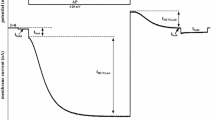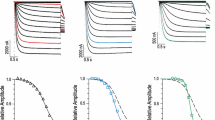Abstract
The objective of the present study was to clarify the mechanism by which the sulfonylurea drug, glibenclamide, inhibits single CFTR channels in excised patches from Xenopus oocytes. Glibenclamide blocks the open pore of the channel via binding at multiple sites with varying kinetics. In the absence of glibenclamide, open-channel bursts exhibited a flickery intraburst closed state (C1); this is due to block of the pore by the pH buffer, TES. Application of 25 μM glibenclamide to the cytoplasmic solution resulted in the appearance of two drug-induced intraburst closed states (C2, C3) of widely different duration, which differed in pH-dependence. The kinetics of interaction with the C3 state, but not the C2 state, were strongly voltage-dependent. The durations of both the C2 and C3 states were concentration-dependent, indicating a non-linear reaction scheme. Application of drug also increased the burst duration, which is consistent with an open-channel blocking mechanism. A kinetic model is proposed. These results indicate that glibenclamide interacts with open CFTR channels in a complex manner, involving interactions with multiple binding sites in the channel pore.









Similar content being viewed by others
Notes
1For simplicity’s sake, this model assumes that the DPC-blocked state and the flickery blocked state (C1) are the same. Although other arylaminobenzoates have been shown to induce intraburst closed states that are separate from the flickery blocked state (McCarty et al., 1993; Zhang et al., 2000), only one intraburst closed time can be resolved in the presence of DPC alone.
References
L. Aguilar-Bryan C.G. Nichols S.W. Wechsler J.P. Clement SuffixIV A.E. Boyd SuffixIII G. González H. Herrera-Sosa K. Nguy J. Bryan D.A. Nelson (1995) ArticleTitleCloning of the β-cell high-affinity sulfonylurea receptor: a regulator of insulin secretion Science 268 423–426 Occurrence Handle7716547
M.P. Anderson D.P. Rich R.J. Gregory A.E. Smith M.J. Welsh (1991) ArticleTitleGeneration of cAMP-stimulated chloride currents by expression of CFTR Science 251 679–682 Occurrence Handle1704151
R. Ashfield P.M. Gribble S.J.H. Ashcroft P.M. Ashcroft (1999) ArticleTitleIdentification of the high-affinity tolbutamide site on the SUR1 subunit of the KATP channel Diabetes 48 1341–1347 Occurrence Handle10342826
A.P. Babenko G. González J. Bryan (1999) ArticleTitleThe tolbutamide site of SUR1 and a mechanism for its functional coupling to KATP channel closure FEBS Lett. 459 367–376 Occurrence Handle10.1016/S0014-5793(99)01215-6 Occurrence Handle10526167
C.E. Bear C. Li N. Kartner R.J. Bridges T.J. Jensen M. Ramjeesingh J.R. Riordan (1992) ArticleTitlePurification and functional reconstitution of the cystic fibrosis transmembrane conductance regulator (CFTR) Cell 68 809–818 Occurrence Handle10.1016/0092-8674(92)90155-6 Occurrence Handle1371239
Z. Cai K.A. Lansdell D.N. Sheppard (1999) ArticleTitleInhibition of heterologously expressed cystic fibrosis transmembrane conductance regulator Cl− channels by non-sulphonylurea hypoglycaemic agents Br. J. Pharmacol. 128 108–118 Occurrence Handle10.1038/sj.bjp.0702748 Occurrence Handle10498841
Z. Cai T.S. Scott-Ward D.N. Sheppard (2003) ArticleTitleVoltage-dependent gating of the cystic fibrosis transmembrane conductance regulator Cl− channel J. Gen. Physiol. 122 605–620 Occurrence Handle10.1085/jgp.200308921 Occurrence Handle14581585
D. Colquhoun A.G. Hawkes (1995) The principles of the stochastic interpretations of ion-channel mechanisms B. Sakmann E. Neher (Eds) Single-Channel Recording Plenum Press New York 397–482
D. Colquhoun F.J. Sigworth (1995) Fitting and statistical analysis of single-channel records B. Sakmann E. Neher (Eds) Single-Channel Recording Plenum Press New York 483–587
G. Cui N.A. McCarty (2003) ArticleTitleProbing a new mechanism of glibenclamide interaction with CFTR: gating effects Biophys. J. 84 83a
D.C. Dawson X. Liu Z.-R. Zhang N.A. McCarty (2003) Anion conduction in CFTR: mechanisms and models K. Kirk D.C. Dawson (Eds) The CFTR Chloride Channel Landes Publishing Georgetown, TX 1–34
H. Fischer T.E. Machen (1994) ArticleTitleCFTR displays voltage dependence and two gating modes during stimulation J. Gen. Physiol. 104 541–566 Occurrence Handle10.1085/jgp.104.3.541 Occurrence Handle7528783
J.P. Giblin K. Quinn A. Tinker (2002) ArticleTitleThe cytoplasmic C-terminus of the sulfonylurea receptor is important for KATP channel function but is not key for complex assembly or trafficking Eur. J. Biochem. 269 5303–5313 Occurrence Handle10.1046/j.1432-1033.2002.03249.x Occurrence Handle12392564
P.E. Golstein A. Boom J. van Geffel P. Jacobs B. Masereel R. Beauwens (1999) ArticleTitleP-glycoprotein inhibition by glibenclamide and related compounds Pfluegers. Arch. 437 652–660 Occurrence Handle10.1007/s004240050829
J. Gupta P. Linsdell (2002) ArticleTitlePoint mutations in the pore region directly or indirectly affect glibenclamide block of the CFTR chloride channel Pfluegers. Arch. 443 739–747 Occurrence Handle10.1007/s00424-001-0762-0
J.W. Hanrahan J.A. Tabcharani (1990) ArticleTitleInhibition of an outwardly rectifying anion channel by HEPES and related buffers J. Membrane Biol. 116 65–77 Occurrence Handle10.1007/BF01871673
C. Haws M.E. Krouse Y. Xia D.C. Gruenert JJ. Wine (1992) ArticleTitleCFTR channels in immortalized human airway cells Am. J. Physiol. 263 L692–L707 Occurrence Handle1282304
H. Ishihara M.J. Welsh (1997) ArticleTitleBlock by MOPS reveals a conformational change in the CFTR pore produced by ATP hydrolysis Am. J. Physiol. 273 C1278–C1289 Occurrence Handle9357772
M. Julien B. Verrier M. Cerutti V. Chappe M. Gola G. Devauchelle F. Becq (1999) ArticleTitleCystic fibrosis transmembrane conductance regulator (CFTR) confers glibenclamide sensitivity to outwardly rectifying chloride channel (ORCC) in Hi-5 insect cells J. Membrane Biol. 168 229–239 Occurrence Handle10.1007/s002329900512
P. Linsdell J.W. Hanrahan (1996) ArticleTitleDisulphonic stilbene block of cystic fibrosis transmembrane conductance regulator Cl− channels expressed in a mammalian cell line, and its regulation by a critical pore residue J. Physiol. 496 687–693 Occurrence Handle8930836
J. Luo M.D. Pato J.R. Riordan J.W. Hanrahan (1998) ArticleTitleDifferential regulation of single CFTR channels by PP2C, PP2A, and other phosphatases Am. J. Physiol. 274 C1397–1410 Occurrence Handle9612228
C.J. Mathews J.A. Tabcharani X.-B. Chang T.J. Jensen J.W. Riordan J.R. Hanrahan (1998) ArticleTitleDibasic protein kinase A sites regulate bursting rate and nucleotide sensitivity of the cystic fibrosis transmembrane conductance regulator J. Physiol. 508 365–377 Occurrence Handle10.1111/j.1469-7793.1998.365bq.x Occurrence Handle9508802
N.A. McCarty (2000) ArticleTitlePermeation through the CFTR chloride channel J. Exp. Biol. 203 1947–1962 Occurrence Handle10851114
N.A. McCarty S. McDonough B.N. Cohen J.R. Riordan N. Davidson HA. Lester (1993) ArticleTitleVoltage-dependent block of the cystic fibrosis transmembrane conductance regulator Cl− channel by two closely related arylaminobenzoates J. Gen. Physiol. 102 1–23 Occurrence Handle10.1085/jgp.102.1.1 Occurrence Handle8397274
S. McDonough N. Davidson H.A. Lester N.A. McCarty (1994) ArticleTitleNovel pore-lining residues in CFTR that govern permeation and open-channel block Neuron. 13 623–634 Occurrence Handle10.1016/0896-6273(94)90030-2 Occurrence Handle7522483
CM. McNicholas W.B. Guggino E.M. Schwiebert S.C. Hebert G. Giebisch M.E. Egan (1996) ArticleTitleSensitivity of a renal K+ channel (ROMK2) to the inhibitory sulfonylurea compound glibenclamide is enhanced by coexpression with the ATP-binding cassette transporter cystic fibrosis transmembrane regulator Proc. Natl. Acad. Sci. USA 93 8083–8088 Occurrence Handle10.1073/pnas.93.15.8083 Occurrence Handle8755607
H. Mehnert E. Karg (1969) ArticleTitleGlibenclamid (HB419): ein neues orales Antidiabetikum der Sulfonycharnstoff-Reihe Deutsche Med. Wochen. 94 819–824
M.V. Mikhailov E.A. Mikhailova S.J. Ashcroft (2001) ArticleTitleMolecular structure of the glibenclamide binding site of the beta-cell K(ATP) channel FEBS Lett. 499 154–160 Occurrence Handle10.1016/S0014-5793(01)02538-8 Occurrence Handle11418131
E. Neher J.H. Steinbach (1978) ArticleTitleLocal anaesthetics transiently block currents through single acetylcholine-receptor channels J. Physiol. 277 153–176 Occurrence Handle306437
D.C. Ogden D. Colquhoun (1985) ArticleTitleIon channel block by acetylcholine, carbachol, and suberyldicholine at the frog neuromuscular junction Proc. Royal Soc. Lond. 225 329–355
S. Okuno M. Inaba Y. Nishizawa A. Inoue H. Mori (1988) ArticleTitleEffect of glyburide and tolbutamide on cAMP-dependent protein kinase activity in rat liver cytosol Diabetes 37 857–861 Occurrence Handle2838357
M.W. Quick J. Naeve N. Davidson H.A. Lester (1992) ArticleTitleIncubation with horse serum increases viability and decreases background neurotransmitter uptake in Xenopus oocytes BioTechniques. 13 358–362
A. Rabe J. Disser E. Fromter (1995) ArticleTitleCl− channel inhibition by glibenclamide is not specific for the CFTR-type Cl− channel Pfluegers Arch. 429 659–662 Occurrence Handle10.1007/BF00373986
J.R. Riordan J.M. Rommens B.-S. Kerem N. Alon R. Rozmahel Z. Grzelczak J. Zielenski S. Lok N. Plavsic J.-L. Chou M.L. Drumm M.C. lannuzzi F.S. Collins L.-C. Tsui (1989) ArticleTitleIdentification of the cystic fibrosis gene: cloning and characterization of complementary DNA Science 245 1066–1072 Occurrence Handle2475911
B.D. Schultz A.D.G. DeRoos C.J. Venglarik A.K. Singh R.A. Frizzell R.J. Bridges (1996) ArticleTitleGlibenclamide blockade of CFTR chloride channels Am. J. Physiol. 271 L192–L200 Occurrence Handle8770056
E.M. Schwiebert D.J. Benos M.E. Egan MJ. Stutts W.B. Guggino (1999) ArticleTitleCFTR is a conductance regulator as well as a chloride channel Physiol. Rev. 79 S145–S166 Occurrence Handle9922379
D.N. Sheppard K.A. Robinson (1997) ArticleTitleMechanism of glibenclamide inhibition of cystic fibrosis transmembrane conductance regulator Cl− channels expressed in a murine cell line J. Physiol. 503 333–345 Occurrence Handle10.1111/j.1469-7793.1997.333bh.x Occurrence Handle9306276
D.N. Sheppard M.J. Welsh (1992) ArticleTitleEffect of ATP-sensitive K+ channel regulators on cystic fibrosis transmembrane conductance regulator chloride currents J. Gen. Physiol. 100 573–592 Occurrence Handle10.1085/jgp.100.4.573 Occurrence Handle1281220
N.C. Sturgess M.L.J. Ashford D.L. Cook C.N. Hales (1985) ArticleTitleThe sulphonylurea receptor may be an ATP-sensitive potassium channel Lancet. 2 474–475 Occurrence Handle10.1016/S0140-6736(85)90403-9 Occurrence Handle2412077
K.B. Walsh K.J. Long X. Shen (1999) ArticleTitleStructural and ionic determinants of 5-nitro-2-(3-phenylpropylamino)-benzoic acid block of the CFTR chloride channel Br. J. Pharmacol. 127 369–376 Occurrence Handle10.1038/sj.bjp.0702562 Occurrence Handle10385235
F. Weinreich J.R. Riordan G. Nagel (1999) ArticleTitleDual effects of ADP and adenylylimidodiphosphate on CFTR channel kinetics show binding to two different nucleotide binding sites J. Gen. Physiol. 114 55–70 Occurrence Handle10.1085/jgp.114.1.55 Occurrence Handle10398692
M.C. Winter D.N. Sheppard M.R. Carson M.J. Welsh (1994) ArticleTitleEffect of ATP concentration on CFTR Cl− channels: a kinetic analysis of channel regulation Biophys. J. 66 1398–1403 Occurrence Handle7520292
A.M. Woodhull (1973) ArticleTitleIonic blockage of sodium channels in nerve J. Gen. Physiol. 61 687–708 Occurrence Handle10.1085/jgp.61.6.687 Occurrence Handle4541078
J. Yamazaki J.R. Hume (1997) ArticleTitleInhibitory effects of glibenclamide on cystic fibrosis transmembrane regulator, swelling-activated, and Ca2+ -activated Cl− channels in mammalian cardiac myocytes Circ. Res. 81 101–109 Occurrence Handle9201033
S. Zeltwanger F. Wang G.-T. Wang K.D. Gillis T.-C. Hwang (1999) ArticleTitleGating of cystic fibrosis transmembrane conductance regulator chloride channels by adenosine triphosphate hydrolysis: Quantitative analysis of a cyclic gating scheme J. Gen. Physiol. 113 541–554 Occurrence Handle10.1085/jgp.113.4.541 Occurrence Handle10102935
S. Zeltwanger Z.-R. Zhang N.A. McCarty (2000) ArticleTitleGlibenclamide inhibits CFTR activity through interaction with multiple sites with varying affinities and pH-dependencies Biophys. J. 78 467A
Z.-R. Zhang S. Zeltwanger N.A. McCarty (2000) ArticleTitleDirect comparison of NPPB and DPC as probes of CFTR expressed in Xenopus oocytes J. Membrane Biol. 175 35–52
Z.-R. Zhang S. Zeltwanger S.S. Smith D.C. Dawson N.A. McCarty (2002) ArticleTitleVoltage-sensitive gating induced by a mutation in the fifth transmembrane domain of CFTR Am. J. Physiol. 282 L135–L145
Z. Zhou S. Hu T.-C. Hwang (2001) ArticleTitleVoltage-dependent flickery block of an open cystic fibrosis transmembrane conductance regulator (CFTR) channel pore J. Physiol. 532 435–448 Occurrence Handle10.1111/j.1469-7793.2001.0435f.x Occurrence Handle11306662
Z. Zhou S. Hu T.-C. Hwang (2002) ArticleTitleProbing an open CFTR pore with organic anion blockers J. Gen. Physiol. 120 647–662 Occurrence Handle10.1085/jgp.20028685 Occurrence Handle12407077
T. Zhu D. Dahan A. Evagelidis S. Zheng J. Luo J.W. Hanrahan (1999) ArticleTitleAssociation of cystic fibrosis transmembrane conductance regulator and protein phosphatase 2C J. Biol. Chem. 274 29102–29107 Occurrence Handle10.1074/jbc.274.41.29102 Occurrence Handle10506164
Acknowledgements
This work was supported by the NSF (MCB-0077575), the American Heart Association (0140174 N) and the Cystic Fibrosis Foundation (MCCART00P0). N.A.M. is an Established Investigator of the American Heart Association. S.Z. was supported by an NIH post-doctoral training grant (DK-07656).
Author information
Authors and Affiliations
Corresponding author
Additional information
These authors contributed equally to this work
Rights and permissions
About this article
Cite this article
Zhang, ZR., Zeltwanger, S. & McCarty, N. Steady-State Interactions of Glibenclamide with CFTR: Evidence for Multiple Sites in the Pore. J Membrane Biol 199, 15–28 (2004). https://doi.org/10.1007/s00232-004-0672-0
Received:
Revised:
Issue Date:
DOI: https://doi.org/10.1007/s00232-004-0672-0




